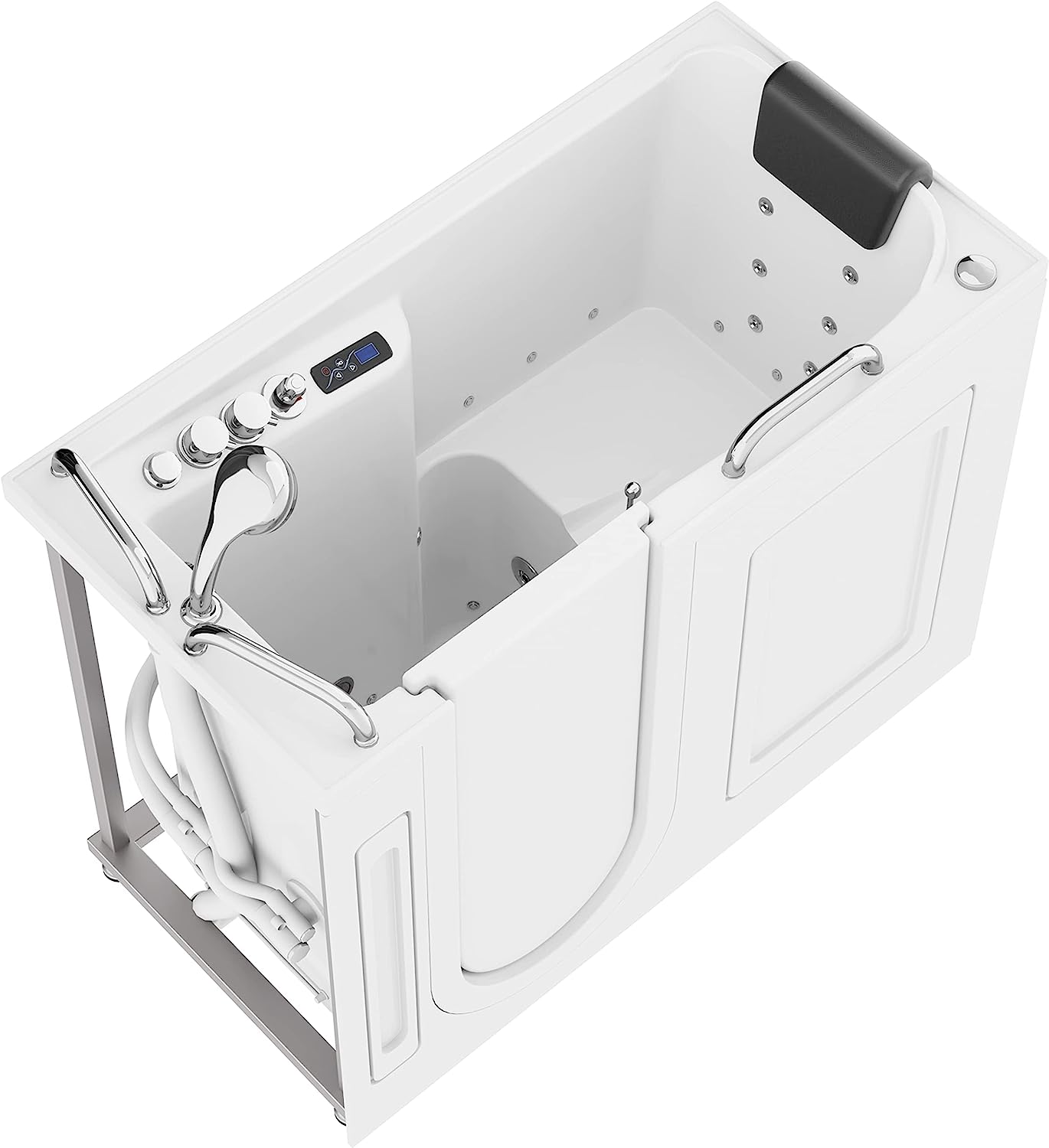Get ready to take a journey through time as we explore the fascinating history and evolution of walk-in tubs. From their humble beginnings as a luxury item to becoming a necessity for many individuals, this comprehensive history delves into the remarkable transformation of walk-in tubs. Discover the innovative features, technological advancements, and the significant impact these tubs have had on the lives of countless individuals. Join us as we uncover the captivating story behind the evolution of walk-in tubs and how they have become an indispensable part of modern living.
Early Development of Walk-In Tubs
Introduction of Walk-In Tubs
Walk-in tubs have come a long way since their inception and have undergone significant advancements in design and technology. These specialized tubs are specifically designed to cater to people with limited mobility, offering a safe and convenient bathing experience. Unlike traditional bathtubs, walk-in tubs have a low barrier entryway and a door that opens and closes, allowing users to enter and exit the tub with ease. This article explores the early development and innovations in walk-in tubs, the benefits they offer to seniors and people with mobility issues, the shift towards accessibility, and the future of this industry.
Early Innovations in Walk-In Tubs
The concept of walk-in tubs first emerged in the mid-20th century as an alternative to traditional bathtubs for people with disabilities. However, early models were primarily functional and lacked the convenience and comfort features that are now available. These tubs featured a basic design with a door at the front, allowing users to easily step in and out. Over time, manufacturers recognized the need for additional advancements to enhance the overall bathing experience, leading to significant improvements in seat design, accessibility features, safety measures, and technological integrations.
Initial Challenges and Limitations
In the early stages of development, walk-in tubs faced certain challenges and limitations that hindered their popularity. One of the main concerns was the size and space required for installation. Walk-in tubs were initially designed to fit into existing bathroom spaces, which often posed limitations due to the dimensions of the tubs. Additionally, the cost of these early models was relatively high, making them inaccessible for a wider demographic. To overcome these challenges, manufacturers had to innovate and make improvements in both the design and cost of walk-in tubs.
Advancements in Walk-In Tub Designs
Improved Seat Design and Accessibility Features
With a focus on comfort and accessibility, manufacturers began to introduce ergonomic seat designs in walk-in tubs. These seats were contoured to provide optimal support and reduce the strain on the user’s body during bathing. Alongside improved seat designs, accessibility features such as grab bars, non-slip flooring, and strategically placed handrails were incorporated into the tubs to ensure users’ safety and stability. These advancements in seat design and accessibility features have played a crucial role in making walk-in tubs more user-friendly and appealing to a wider audience.
Incorporation of Hydrotherapy and Massage Systems
One of the key advancements in walk-in tub designs was the incorporation of hydrotherapy and massage systems. Hydrotherapy, which involves the use of water jets and air bubbles, provides therapeutic benefits by promoting relaxation, improving blood circulation, and reducing pain and inflammation. By integrating these features into walk-in tubs, users can experience the benefits of hydrotherapy in the comfort of their own homes. The addition of massage systems further enhances the bathing experience, offering a spa-like sensation that can alleviate muscle tension and promote overall well-being.
Enhancements in Safety Features and Technology
To ensure maximum safety for users, walk-in tub manufacturers have continuously improved safety features and integrated advanced technologies. A notable safety feature is the anti-scald system, which prevents the water from reaching dangerously high temperatures. This feature is particularly important for individuals with reduced sensitivity to heat. Other safety features include leak-proof doors, low-entry thresholds, and easy-to-reach controls. Furthermore, the incorporation of technology such as voice-activated controls, LED lighting, and temperature sensors has made walk-in tubs more user-friendly and convenient.
Walk-In Tubs: A Luxury for the Elderly
Rise in Popularity among Baby Boomers
Walk-in tubs have gained immense popularity among the elderly, especially the baby boomer generation. As this demographic continues to age, there is a growing demand for products and solutions that address their specific needs. Walk-in tubs provide a luxurious and convenient bathing experience, ensuring the safety and well-being of seniors. The rise in popularity among baby boomers has contributed to the increased demand for walk-in tubs, prompting manufacturers to cater to this market segment with a range of customization options and high-end features.
Benefits for Seniors with Mobility Issues
Seniors with mobility issues often face challenges when using traditional bathtubs, increasing the risk of slips, falls, and injuries. Walk-in tubs offer a safe bathing solution by eliminating the need to step over high bathtub walls. The low-entry threshold and sturdy handrails provide stability and support, enabling seniors to bathe independently with confidence. Additionally, the therapeutic benefits of hydrotherapy and massage systems can alleviate joint pain, stiffness, and muscle aches, improving the overall well-being of seniors with mobility issues.
Customization and High-End Options
Walk-in tubs are available in various designs and sizes to cater to individual preferences and bathroom requirements. Manufacturers offer customization options such as adjustable seat heights, additional grab bars, and specialized features tailored to specific needs. High-end walk-in tubs often include luxurious features such as chromotherapy lighting, built-in radios, and aromatherapy capabilities. These customization and high-end options reflect the desire to provide seniors with a spa-like experience while addressing their specific mobility and comfort needs.
Walk-In Tubs for Health and Wellness
Hydrotherapy’s Impact on Physical Rehabilitation
Hydrotherapy, a key feature in walk-in tubs, has proven to be beneficial for physical rehabilitation. The buoyancy of water reduces the impact on joints and muscles, allowing individuals recovering from injuries or surgeries to engage in gentle exercises. Hydrotherapy helps improve range of motion, muscle strength, and flexibility, contributing to a faster recovery and improved overall physical well-being. Walk-in tubs with hydrotherapy features enable individuals to conveniently access these rehabilitative benefits in the comfort of their own homes.
Relief from Chronic Pain and Arthritis
One of the primary benefits of walk-in tubs is their ability to provide relief from chronic pain and arthritis. The combination of warm water and hydrotherapy jets can alleviate joint pain, reduce inflammation, and improve circulation. This can significantly improve the quality of life for individuals suffering from conditions such as arthritis, fibromyalgia, and chronic back pain. Regular use of walk-in tubs can promote relaxation, reduce muscle tension, and enhance overall pain management, allowing individuals to experience a greater sense of well-being.
Psychological Benefits and Stress Reduction
In addition to the physical benefits, walk-in tubs also offer psychological benefits, promoting relaxation and stress reduction. The warm water and soothing hydrotherapy jets create a calming environment that can help individuals unwind and alleviate stress. Taking a bath in a walk-in tub can become a therapeutic ritual and a means of self-care. The experience of relaxation and rejuvenation in a walk-in tub can have a positive impact on mental well-being, reducing anxiety, improving sleep quality, and promoting a sense of tranquility.
The Shift towards Accessibility
Increasing Demand for Aging-in-Place Solutions
As individuals age, there is often a desire to remain in the comfort and familiarity of their own homes rather than move to assisted living facilities. This has led to a significant increase in the demand for aging-in-place solutions, including walk-in tubs. Walk-in tubs provide seniors with the ability to maintain their independence and privacy while ensuring their safety and well-being. The accessibility features and therapeutic benefits offered by walk-in tubs make them a practical choice for individuals who wish to age in place.
Walk-In Tubs as a Safer Alternative to Traditional Bathtubs
Traditional bathtubs can pose a significant risk for individuals with limited mobility, increasing the chances of slips, falls, and injuries. Walk-in tubs, on the other hand, offer a safer bathing option by addressing these risks. The low-entry threshold allows individuals to enter the tub without stepping over high walls, reducing the chances of accidents. The presence of handrails and non-slip flooring further enhances safety, providing users with the support and stability they need. By eliminating the barriers and hazards associated with traditional bathtubs, walk-in tubs ensure a safer bathing experience for individuals of all ages.
Regulatory Requirements and Standards
The shift towards accessibility in walk-in tubs has also been influenced by regulatory requirements and standards. Manufacturers abide by industry standards and guidelines to ensure that walk-in tubs meet safety requirements and provide a high level of accessibility. These standards include the design of the door, the stability of handrails, and the incorporation of anti-scald and other safety systems. Compliance with these regulations not only ensures the safety and well-being of users but also instills confidence in the market, encouraging individuals to choose walk-in tubs as a reliable accessibility solution.
Affordability and Market Expansion
Decrease in Walk-In Tub Costs
Initially, walk-in tubs were considered a luxury item and were often inaccessible due to their high costs. However, over the years, advancements in manufacturing processes and increased competition have resulted in a decrease in walk-in tub costs. The declining costs have made walk-in tubs more affordable and accessible to a wider range of individuals. This affordability has contributed to the expanded market for walk-in tubs and has allowed more people to enjoy the benefits of these specialized tubs.
Financial Assistance and Medicare Coverage
To further support affordability, various financial assistance options are available for individuals seeking walk-in tubs. Some manufacturers offer financing programs or installment plans to help make the purchase more manageable. Additionally, certain insurance policies may cover the cost of walk-in tub installations, providing financial relief for individuals with specific medical conditions. Medicare, a government-funded health insurance program, may also cover a portion of the cost of a walk-in tub if it is considered necessary for medical reasons.
Competitive Market and Consumer Options
The increasing demand for walk-in tubs has led to a competitive market, with a wide range of options available to consumers. Manufacturers have introduced various models with different features, designs, and price points to cater to individual preferences and budgets. The competition has driven innovation and encouraged manufacturers to continuously improve the quality, functionality, and affordability of their products. With an array of consumer options, individuals can choose walk-in tubs that best meet their needs and preferences.
Innovations in Walk-In Tub Technology
Smart Features and Remote Control Functions
As technology continues to advance, walk-in tubs have embraced smart features and remote control functions. Some newer models offer features such as voice-activated controls, digital thermostats, and water level sensors. These smart features allow individuals to adjust the temperature, control the jets, and monitor water levels with ease. Remote control functions offer convenience and accessibility, ensuring that individuals can operate the tubs comfortably without needing to bend or strain themselves.
Integrating Assistive Devices and Connectivity
Walk-in tub technology has also explored the integration of assistive devices and connectivity. For individuals with mobility issues, walk-in tubs can be equipped with additional assistive devices such as lift systems, hydraulic chairs, and transfer benches. These devices further enhance accessibility and make it easier for individuals to safely enter and exit the tubs. Furthermore, walk-in tubs can be connected to smart home systems, allowing users to control and monitor their tubs using smartphones or other devices.
Emerging Trends in Walk-In Tub Designs
The future of walk-in tubs is shaped by emerging trends in design and functionality. Manufacturers are exploring new materials and finishes that offer enhanced durability, hygiene, and aesthetics. Walk-in tubs with customizable options, allowing users to choose from a variety of colors, styles, and additional features, are becoming increasingly popular. Design innovations also focus on creating tubs that blend seamlessly with the overall bathroom decor, providing a cohesive and visually pleasing bathing experience. As the industry continues to evolve, consumers can expect further advancements and new trends in walk-in tub designs.
Environmental Considerations
Energy Efficiency and Sustainability
Environmental considerations are becoming increasingly important in the design and manufacturing of walk-in tubs. Manufacturers are incorporating energy-efficient features to reduce the energy consumption of these tubs. This includes the use of insulation materials to maintain water temperature and reduce heat loss. By prioritizing energy efficiency, walk-in tubs not only minimize environmental impact but also help users save on energy costs.
Water Conservation and Eco-Friendly Features
Another environmental consideration in walk-in tubs is water conservation. Manufacturers are developing tubs with features such as water-efficient faucets and drains to minimize water usage. Additionally, some walk-in tubs are designed to recycle and filter water, allowing it to be reused for multiple baths. These eco-friendly features promote sustainable water usage and minimize water wastage.
Green Certifications and Standards
To ensure the environmental credentials of walk-in tubs, manufacturers seek green certifications and adhere to eco-friendly standards. Certifications such as ENERGY STAR and LEED (Leadership in Energy and Environmental Design) indicate that the tubs meet or exceed stringent requirements for energy efficiency and sustainability. These certifications provide consumers with assurance that the walk-in tubs they choose are environmentally responsible choices.
Challenges and Limitations
Installation Requirements and Space Constraints
One of the challenges associated with walk-in tubs is the installation process, which often requires specific plumbing and electrical considerations. Walk-in tubs may require modifications to existing bathrooms, including the installation of larger water heaters and specialized drainage systems. Additionally, the dimensions of walk-in tubs may not fit into all bathroom spaces, leading to space constraints and the need for further remodeling. Overcoming these challenges requires careful planning and professional installation to ensure that the walk-in tubs function properly and fit seamlessly into the bathroom.
Maintenance and Cleaning Considerations
Like any other household fixture, walk-in tubs require regular maintenance and cleaning to ensure their longevity and optimal performance. Care must be taken to clean the tub surfaces, jets, and any filters or screens to prevent the buildup of mold, mildew, or bacteria. It is important to follow manufacturer guidelines and use appropriate cleaning agents to prevent damage to the tub’s materials or components. Proper maintenance and cleaning practices are necessary to keep the walk-in tubs in good condition and ensure they continue to provide a safe and enjoyable bathing experience.
Limited Availability in Certain Regions
While the popularity of walk-in tubs continues to grow, their availability may be limited in certain regions. Manufacturers may have distribution networks that prioritize certain areas, making it more challenging for individuals in other regions to access these tubs. Limited availability can also impact the after-sales support and servicing options for walk-in tub users. However, as the demand for walk-in tubs increases and the industry expands, it is likely that availability will improve, providing individuals in all regions with easier access to these specialized tubs.
Future of Walk-In Tubs
Innovation in Accessibility and Safety Features
Looking ahead, the future of walk-in tubs holds great promise in terms of innovation in accessibility and safety features. Manufacturers will continue to focus on improving the usability and comfort of walk-in tubs for individuals with limited mobility. This includes advancements in features such as enhanced stability, easier door operation, and improved handrail designs. By prioritizing accessibility and safety, walk-in tubs will continue to evolve and meet the evolving needs of users.
Integration with Smart Home Technology
As smart home technology becomes more prevalent, walk-in tubs are expected to integrate seamlessly with these systems. This integration will enable users to control and monitor their tubs through voice commands or smartphone applications. Smart features such as water temperature presets, personalized massage settings, and voice-activated controls will enhance the overall bathing experience. The integration with smart home technology will make walk-in tubs even more user-friendly, convenient, and accessible.
Expanding Market and Global Reach
The market for walk-in tubs is expected to expand globally as the demand for accessible bathing solutions continues to grow. Aging populations worldwide, along with increased awareness of the benefits of walk-in tubs, will contribute to the increased adoption of these specialized tubs. Manufacturers will strive to meet the needs of diverse demographics by offering a range of models, features, and customization options. As the market expands, manufacturers will likely establish a broader global presence, ensuring that individuals worldwide can benefit from the convenience and safety offered by walk-in tubs.
In conclusion, the early development of walk-in tubs paved the way for significant advancements in design, functionality, and accessibility features. As these specialized tubs became more popular, their benefits for the elderly and individuals with mobility issues became increasingly apparent. The shift towards accessibility in walk-in tubs reflects the growing demand for aging-in-place solutions and the emphasis on safety and convenience. Furthermore, the future of walk-in tubs holds great promise, with innovation in technology and design boosting their appeal and accessibility. As the market continues to expand, walk-in tubs are set to become a necessity for individuals seeking a safe, therapeutic, and luxurious bathing experience.





